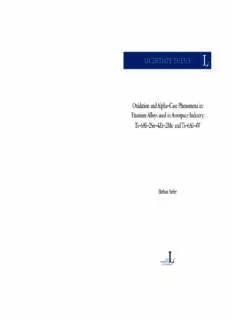
Oxidation and Alpha–Case Phenomena in Titanium Alloys used in Aerospace Industry PDF
Preview Oxidation and Alpha–Case Phenomena in Titanium Alloys used in Aerospace Industry
ISSN: 1402-1757 ISBN 978-91-7439-XXX-X Se i listan och fyll i siffror där kryssen är LICENTIATE T H E S IS B ir h a n S Department of Engineering Sciences and Mathematics e fe Division of Materials Science r O x id Oxidation and Alpha–Case Phenomena in a ISSN 1402-1757 tio n ISBN 978-91-7439-927-1 (print) an Titanium Alloys used in Aerospace Industry: d ISBN 978-91-7439-928-8 (pdf) A lph Ti–6Al–2Sn–4Zr–2Mo and Ti–6Al–4V Luleå University of Technology 2014 a– C a se P h e n o m e n a in T ita n iu m A llo y s u se d in A e Birhan Sefer ro sp a c e I n d u str y : T i– 6 A l– 2 S n – 4 Z r – 2 M o a n d T i– 6 A l– 4 V LICENTIATE THESIS Oxidation and Alpha–Case Phenomena in Titanium Alloys used in Aerospace Industry: Ti–6Al–2Sn–4Zr–2Mo and Ti–6Al–4V Birhan Sefer Division of Materials Science Department of Engineering Sciences and Mathematics Luleå University of Technology © 2014 Birhan Sefer Engineering Materials Division of Materials Science Department of Engineering Sciences and Mathematics Luleå University of Technology SE–971 87 Luleå PPrriinntteedd b byy U Lnuivleeår sUitentsivtreyrcskiteyr ioetf, T Leuclhenå o2l0o1g4y , Graphic Production 2014 ISSN: ISSN 1402-1757 IISSBBNN (9p7ri8n-t)9 1-7439-927-1 (print) ISBN 978-91-7439-928-8 (pdf) ISBN (pdf) Luleå 2014 Luleå 2014 www.ltu.se www.ltu.se To my parents, my brother and my wife Elma iii iv ABSTRACT Titanium and its alloys are attractive engineering materials in aerospace industry because of their outstanding mechanical properties such as high specific strength and excellent corrosion resistance. Ti–6Al–2Sn–4Zr–2Mo (Ti–6242) and Ti–6Al–4V (Ti–64) are two alloys commonly used for manufacturing components in jet engines, such as fan blades, disks, wheels and sections of the compressor where the maximum temperature is in the range of 300–450 °C. At temperatures above 500 °C and in oxygen containing environments, these alloys are oxidizing rapidly. Oxidation normally involves formation of an oxide scale on top of the metal and a hard and brittle oxygen enriched layer beneath the scale which is known as “alpha–case”. The alpha–case layer has a detrimental effect on important mechanical properties such as ductility, fracture toughness and especially the fatigue life when an engine component is subjected to dynamic loading. In order to increase the understanding of the oxidation and alpha–case phenomena, the behaviour of these two alloys after long time exposure in air at elevated temperature has been investigated. Heat treatments were performed on Ti–6242 and Ti–64 alloys in ambient air at 500, 593 and 700 °C for times up to 500 hours. The oxide scale and the alpha–case layer were analysed, characterized and compared for both alloys. It was found that the oxide scale and alpha–case thickness are functions of temperature and time. Faster and more complex oxidation kinetics was noted in Ti–64, whereas in Ti–6242 the oxidation kinetics was found moderate at all tested temperatures and times. Discrepancies in the oxidation kinetics are believed to be because of the differences in the chemical composition and the microstructure of the two alloys. In addition, different morphology of the oxide scales was observed after 500 hours exposure time at 700 °C. The thickness of the alpha–case layer was measured using conventional metallographic and microscopic techniques. It was found that in both alloys the alpha–case growth obeys parabolic law with respect to time at all three tested temperatures. In addition, the diffusion coefficients and the activation energy of oxygen diffusion were estimated in the temperature range of 500–700 °C for the two alloys. Electron probe micro analyser (EPMA) was used to measure the oxygen concentration along the thickness of the alpha–case layer. It was found that the oxygen concentration decreases along the alpha–case layer. The oxygen concentration profiles were used to estimate the alpha–case thicknesses and it was found good agreement with the optically measured values for almost all investigated temperatures and times. Only at 700 °C in the time interval 300–500 hours in Ti–6242 a difference between the results from the two methods was found. Moreover, the EPMA concentration profiles of the main α and β alloying elements, before and after heat treatment at 700 °C for 500 hours, revealed microstructural changes and an increase of the α–phase volume fraction in the two investigated alloys. Keywords: Titanium alloys, Microstructure, Oxidation, Oxygen diffusion, Oxide Scale, Alpha–case, SEM and EPMA. v vi PREFACE The research described in this thesis has been carried out at the Division of Materials Science, Luleå University of Technology (LTU) between September 2012 and May 2014. Three collaborators are involved in this project: Luleå University of Technology (LTU), the Polytechnical University of Catalonia (UPC) and GKN Aerospace Engine Systems in Trollhättan, Sweden. The thesis comprises of introduction to the research field and compilation of the following papers: Paper I Raghuveer Gaddam, Birhan Sefer, Robert Pederson, Marta–Lena Antti, Study of alpha–case depth in Ti–6Al–2Sn–4Zr–2Mo and Ti–6Al–4V, Institute of Physics Conference Series: Materials Science and Engineering, 2013 (In Press). Paper II Raghuveer Gaddam, Birhan Sefer, Robert Pederson, Marta–Lena Antti, Oxidation and alpha– case formation in Ti–6Al–2Sn–4Zr–2Mo alloy, submitted for publication. Paper III Birhan Sefer, Raghuveer Gaddam, Antonio Mateo, Robert Pederson, Marta–Lena Antti, Characterization of the oxide scale and alpha–case layer in Ti–6Al–4V and Ti–6Al–2Sn–4Zr– 2Mo in the temperature range 500–700 °C, to be submitted for publication. Luleå, May 2014 Birhan Sefer vii viii
Description: